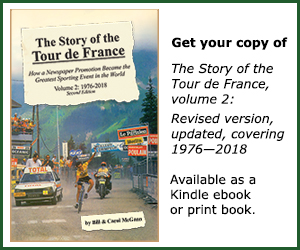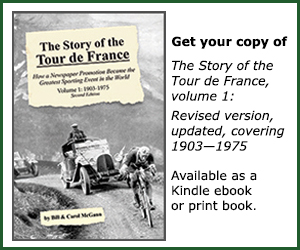

Charly Gaul: Murderous Climber on a Murderous Climb
By Les Woodland
An excerpt from Cycling's 50 Triumphs and Tragedies: The Rise and Fall of Bicycle Racing's Champions
Back to the list of rider histories
Les Woodland has been kind enough to let me excerpt a chapter from his book "Cycling's 50 Triumphs and Tragedies". You can learn more about this erudite, yet fun book (available in print, Kindle eBook and Audio Book versions) by clicking here.
MURDEROUS CLIMBER ON A MURDEROUS CLIMB
Monte Bondone, Italy, June 8, 1956
It was, said one writer, a prehistoric race never equaled in post-war racing. Triumph met tragedy that day because an angel flew and then fell to earth.
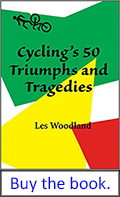
It stands a little to the west of Trento, a beautiful city in northern Italy, a fourteen-kilometer climb with thirty hairpins in the Italian Alps. The mountain itself reaches 2,180 meters, the road across it 1,300. The actual climbing from bottom to top is 1,008. It was no surprise that it was in the Giro d’Italia of 1956.
Why would it not be?
It was no surprise, either, when Charly Gaul broke away. He was one of the most talented climbers of his era and a man who did best when the weather was against him. And that day it was against everyone. Snow began falling and Gaul, sensing his day, was alone with 88 kilometers still to go. And the snow carried on falling. Riders scattered across the countryside, more concerned with their future than that of the race and their rivals.
That morning, Gaul said to Raphaël Géminiani: “Go and tell your guy [Louison Bobet, whom he disliked with a passion] that if he’s got good toe-straps, he’s going to find them useful.” Riders in those days used toe-straps to pull up the pedals as they climbed hills. Géminiani dutifully told Bobet, his team leader. “So, stick on his wheel,” Bobet told him.
“But after a kilometer, Gaul had dropped me,” Géminiani remembered. “Bobet asked me why I’d let him go. I said: ‘Some hope! He didn’t even ask my permission!’”

Charly Gaul and Louison Bobet in stage 17 of the 1955 Tour de France
Géminiani said Gaul was “a murderous climber, always the same sustained rhythm, a little machine with a slightly higher gear than the rest, turning his legs at a speed that would break your heart: tick tock, tick tock, tick tock.” And Gaul tick-tocked on upwards.
VeloNews recalled: “The weather turned colder and colder, and on the long, steep slopes of the Giro’s final mountain, light snow soon turned to a full blizzard as the temperature dropped to freezing point. [Leader Pasquale] Fornara was overcome by the cold and took refuge in a farmhouse. Other race leaders rode to a standstill before keeling over in the ditches. Some stopped to drink hot chocolate or dip their freezing hands in bowls of hot water offered by the spectators.”
Managers turned up the heating in their cars and hoped for the best, peering through clogged windshields which wipers struggled to clear. René de Latour wrote in Sporting Cyclist: “A search was going on for a missing man. The searcher-in-chief was former world champion Learco Guerra, now manager of the Faema team. The man he was looking for was Charly Gaul, who had not been seen for the last twenty minutes. Guerra was driving his car up the mountain pass, peering through the clogged-up windscreen when, by sheer chance, he saw a bike leaning against the wall of a shabby mountain trattoria. ‘That’s Charly’s bike!’ he exclaimed to his mechanic.
“They rushed into the bar and there, sitting on a chair sipping hot coffee, was Charly Gaul, exhausted, so dead to the world that he could hardly speak. Guerra knows bike riders. He talked gently to Gaul. ‘Take your time, Charly,’ he said. ‘We’re going to take care of you.’ While a masseur was ripping off Gaul’s wet jersey, Guerra had some water warmed and poured it over the rider’s body. Then, rubbed down from head to toes, Gaul’s body gradually came back to life. He lost that glassy look and in a few minutes he was a new man again.”
Gaul had been riding in shorts and short sleeves, foolish, naive or impervious.
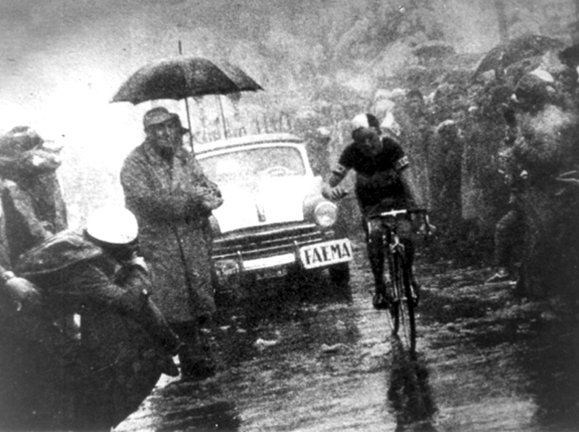
Charly Gaul on Monte Bondone on that terrible day in the 1956 Giro d'Italia
“With the encouragement of his followers he managed to reach the top, literally miles ahead of Fiorenzo Magni, who finished second at 12¼ minutes. The cheering spectators could hardly believe that men had suffered such hardships up there in the icy mountain. On the way, 44 had fallen by the wayside.” Other reports say it was 46, some even 60, but with numbers like that it hardly matters. Gaul got to the top more than twelve minutes before Magni, the previous year’s winner.
Magni recalled years later: “It snowed the whole day and it was very cold. I hadn’t noticed how much. Along the way I saw many bikes parked next to bars and I asked what was going on. They told me that most of the peloton froze and had to quit. Then, before reaching Trento, I saw the race leader [Pasquale Fornara] quitting too! What? Am I seeing things, I wondered. If I were the Pink Jersey I would have continued even if I had to walk, but I would never abandon.”
Federico Bahamontes could have led the race had he stayed with Magni. But he and Jesús Galdeano preferred to struggle through the snow to an empty farmhouse. There they found pajamas and put them on. “I had frostbite in my hands and feet,” Bahamontes said. “I couldn’t use them properly for a month. I’d never known such bad weather. It was really frightening. We just stopped wherever we could, two here, six there, wherever you were, you abandoned.”
Another version is that a peasant found Bahamontes in a ditch and called the finish to say: “I’ve got a cyclist here with me and he doesn’t speak Italian. What should I do with him?”
Others had no choice. Nino de Filippis rode to a standstill and, his frozen fingers clamped to the handlebars, simply keeled over sideways. Some say it was then that Bahamontes decided to pull out.
Gaul was too cold and tired after nine hours and 242 kilometers to lift a hand to acknowledge the cheers of those courageous enough to brave the weather and who had, in any case, been lucky to get up there and were now concerned with how they were going to get back down again. Soldiers pulled him from his bike and wrapped him in blankets. They carried him to a hut where they gave him coffee and more blankets. Legend says that, even an hour later, his soigneur had to cut his jersey off because Gaul’s frozen skin was too tender for the jersey to be pulled off. Gaul then fainted. When he came round, Gilles Le Roc’h said, he could no longer remember what had happened.
It was a prehistoric stage, Philippe Brunel wrote in L’Équipe, “never equaled in the long history of post-war road racing.” Few riders that day rode all the way by bike. Most had taken a truck, anything that offered a lift, some of the way. All Gaul’s team pulled out and went home.
“We were picked up by a truck,” Bahamontes said. “We all quit. Anybody who says the opposite is lying because then they came by the hotels next day asking who wanted to finish the Giro.”
They hold a cyclosportive ride over the Bondone these days and they name it in honor of the man who made it famous. The first was in 2006 and not surprisingly there were 40 from Luxembourg, Gaul’s home country, to keep the memory alive. Not bad for a story 50 years old and a country smaller than Rhode Island. And that same year the Giro ended one of its stages on the Bondone in tribute.
It was Pierre About, writing in L’Équipe, who first referred to Gaul as the angel of the mountains. The phrase came to him after he’d seen Gaul’s expressionless, childlike face—Gaul was only 21 at the time, riding a race restricted to riders under 25—as he won the Circuit des Six Provinces in eastern central France. About wrote: “When Charly Gaul met with the terrible ascent of the Chaubouret, one forgot that he had been looking like a man who fought and suffered. An irresistible lightness suddenly took hold of this young boy with the doll’s eyes, and he gave the impression of an angel for whom nothing is difficult. Light, harmonious, he rode away from the field.”
Gaul had turned professional the previous summer for a French team, Terrot, and had immediately startled the old guard by coming second in the Dauphiné Libéré and winning the mountains competition. In the Six Provinces he had ridden alone over the Croix du Chaubouret into the bike-making city of St-Étienne.
Legend says Gaul sometimes received 60 letters a day from lip-smacking women. He gave some to his team-mate, Marcel Ernzer, after which Ernzer said he wasn’t at all sure he’d marry if that was what women wanted.

Charly Gaul and his Faema team celebrate his victory at the end of the 1956 Giro d'Italia
Men with prickly personalities fall out badly over the most trivial things. For Gaul and Louison Bobet, the French star, it was the etiquette of peeing beside the road. Etiquette said stars respected each other and didn’t attack when one stopped. But in a Giro stage to Trieste, Jan Heine recorded: “Bobet stopped to relieve himself, and Gaul did the same. It is a slow stage, so Gaul gave his bike to Ernzer and stepped off the road. Suddenly, he heard his teammates shout and saw Bobet and the French racing off.”
Gaul had to chase for 80 kilometers and lost the lead. He never forgave Bobet’s duplicity, as he saw it. He reminded Bobet he’d worked in an abattoir at Bettembourg and that, if the Frenchman carried on annoying him, he’d pick up a knife and take revenge. That same year—1958—he taunted Bobet by telling him just where he’d attack in the mountains and defying him to follow. It was when he attacked on the Col de Luitel as he warned and had to keep going for fear that Bobet would catch him that he pioneered peeing as he rode, which earned him the nickname Monsieur Pee-Pee. It haunted him for the rest of his life.
Bahamontes, his rival in the mountains, said Gaul “had a very strong character, terrible even.” He was so unpopular, says Heine, that “many of his problems appear to have been caused by a hostile peloton, which often seemed to do anything to make Gaul lose.” Philippe Brunel assessed his personality as “notorious: he was a man of the cold, a man who created great impressions [but was] taciturn, a man of few words who spoke only to close acquaintances.” He was, Géminiani said: “A man with two faces and a paradox in the way he behaved. He could have the most violent of tempers but he could also have the most gentle of characters.”
Gaul came close to retiring in 1962, declining fast, rootless after Ernzer called it a day. He left the Gazzola team to its relief, made a mess of a comeback with Peugeot and then with Lamote-Libertas—when he was jeered by a crowd in his own country—then gave up. He rode his last race not on the road but on the Niederkom velodrome, in 1965. He opened a bar near the train station in Luxembourg City but closed the doors again six months later.
He threw up everything and went off to live in a forest hut on the Lipperscheid hill in the Ardennes. And there he disappeared, far from welcoming to the few who found him and unrecognizable to many. He grew fat and grew a beard. He dressed in hunter’s green fatigues and walked the woods, watching the deer, listening to the birds. He had a phone but never answered it. He took his name out of the directory.
Local shopkeepers said he had never recovered from the end of his second marriage. But nobody knew. To anyone who asked for an interview, he said: “I don’t feel like talking. Sorry. It was all so long ago. Please, leave me in peace. I’m just a grumpy old man.”
Sometimes, though, he’d stand beside the road during the Tour of Luxembourg, just another spectator that few recognized. And then, in 1983 and on the twenty-fifth anniversary of winning the Tour, his debt to himself paid, he came back to life. The impassive blue eyes were still there but little else. He did, though, have a third wife, Josée, and a daughter, Fabienne. They lived at Itzigerste, a suburb to the southwest.
“I bought myself a little portable TV,” he told Pilo Fonck, a journalist who said he had “the interview of my life; I was as happy as a little kid.”
Gaul told him: “I connected it to the battery of my car so that I could watch stages of the Tour de France. When the battery got flat, I called the man at the garage. I didn’t travel much. I said to myself: ‘You’re at peace here, you’re happy.’ There’s nothing but trees and water. I spent my days planting vegetables and the deer came to eat at the end of my garden.”
Why the breakdown and reclusion? Maybe because he had never been an easy man, never at ease with others. Maybe because he had had enough of a life that had turned from adulation to being whistled by his own people. And perhaps because of amphetamine psychosis.
Gaul often rode with staring if expressionless eyes and with flecks of foam on his lips. Bahamontes said tactfully that he liked hot days “because my rivals did less well.” Amphetamine, then common in cycling and still not against the rules, was less effective in the heat. And Gaul always rode best in the cold. Amphetamine also played with the mind, as Erik De Vlaeminck found.
Marcel Ernzer remembered a conversation with his leader and room-mate:
“Charly is going to die,” Gaul said of himself.
“Why do you say that?”
“Because Charly takes too many pills.”
“But everybody takes them.”
“Yes, but Charly takes a lot more than the others.”
The nation decided in time that it could no longer ignore the greatest hero so small a country had produced. It suggested he work as an archivist at the sports ministry. And there he began working out his life, what he’d done, recompiling it like a puzzling jigsaw.
In 1989 the Tour started in Luxembourg City and the organizer, Jean-Marie Leblanc, gave Gaul the Tour de France’s commemorative medal. In 2000 he invited him to sit on the podium as its star guest at the end of stages. Spectators who remembered his exploits as a lean and pale-faced boy stood in admiration but wondered if this was the man they had adored. Gaul sat staring back at them.
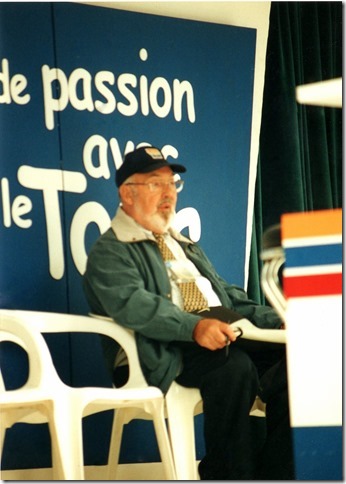
Charly Gaul on the podium of the Tour de France
It was impossible to read his thoughts. It was hard to say if he even knew what was going on.
Charly Gaul died on December 6, 2005.
We hope you enjoyed this story. There is lots more in Cycling's 50 Triumphs and Tragedies: The Rise and Fall of Bicycle Racing's Champions


